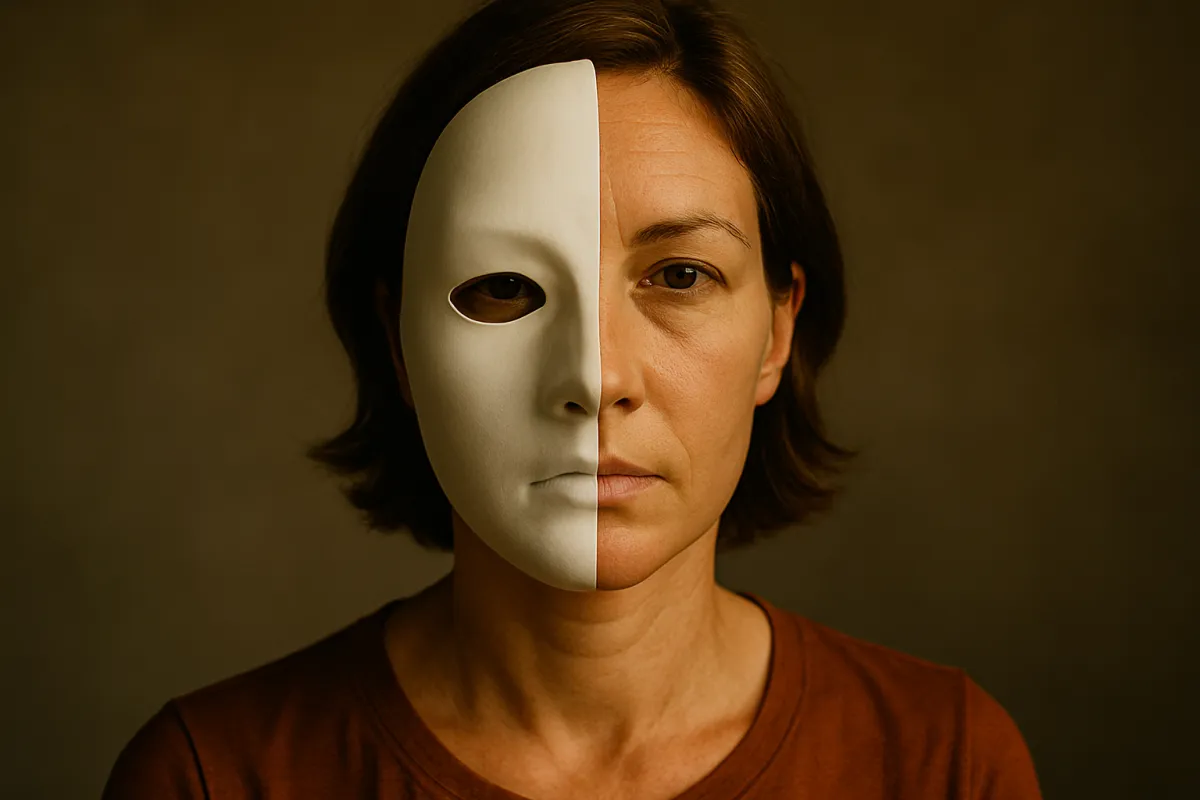
The Masking: The Cost of Being the Capable One
You’ve spent years adapting—polishing, smoothing, performing—until “fine” became your default setting.
But lately, the mask feels heavy.
This isn’t about vanity or rebellion. It’s about remembering who you were before the performance.
This is The Masking—the moment you finally start to see your real face again.
The Masking:
The Cost of Being the Capable One
When You Become the Version of Yourself the World Wants
You keep your voice even, your face pleasant, your tone measured. You adapt to rooms the way other people change clothes. Somewhere along the line, that becomes your superpower — and your cage.
You can hold it all together.
You can look fine even when you’re falling apart.
You can smile through the migraine, the heartbreak, the hormonal chaos. You can make it all look effortless, because that’s what’s rewarded.
You call it “high-functioning.”
The world calls it “impressive.”
But really, it’s masking — and you’re exhausted.
How Beauty, Perfection, and People-Pleasing Became the Costume You Forgot to Take Off
Masking isn’t always intentional. It’s the quiet survival strategy that becomes a habit. It’s knowing which version of yourself fits where: the polite professional, the easygoing friend, the glamorous wife, the calm mother, the one who never makes anyone uncomfortable.
It’s a lifetime of reading the room before you ever read yourself.
You’ve worn so many masks you’ve started sculpting your own face to match them — literally. A little Botox, a little filler, a little contour to smooth the edges between the version you are and the version that’s expected. Because this world trains women to erase signs of wear, as if wisdom should come without evidence.
You remember the first time you looked in the mirror and saw the faintest crease — and felt not age, but danger.
Danger of becoming invisible.
Danger of being seen differently.
Danger of being dismissed.
The Cost of Always Looking “Fine”
So you did what women have always done: you adapted.
You colored, you polished, you optimized. You learned the art of “looking fine.” You became fluent in apology — for your face, your body, your voice, your opinion, your exhaustion.
The film world, the social world, even the parenting world — they all rewarded it. Aesthetic composure became moral virtue. You looked radiant, therefore you must be okay.
You looked young, therefore you must still matter.
You looked perfect, therefore you must have your life together.
It worked for a while.
Until it didn’t.
The Moment You Start to See the Real You Again
Because masking always costs more than it gives.
It disconnects you from the wild, breathing self underneath — the one who laughs too loud, gets angry, forgets things, has needs. The one who wants off the hamster wheel of constant improvement.
And now, somewhere in your late forties, you start to feel the strain. The edges between the mask and the skin are getting harder to manage. The performance is slipping. You’re noticing how tight it’s become — the smiling through gritted teeth, the saying “it’s fine” when it’s not, the swallowing of every impulse that doesn’t fit the script.
Maybe you’ve started catching glimpses of your real face in unguarded moments — in the rearview mirror, in a kitchen window reflection — and realizing how tired you look when you stop performing.
And maybe, quietly, you think: That’s the real me.
And she’s… kind of beautiful.
Is Your Armor Serving You?
There’s a particular grief in seeing how long you’ve lived for everyone else’s comfort. You can almost map it across your features: the practiced brow, the polite lips, the over-smoothed expression. You’ve been playing a role called “the woman who has it together” for decades — and now your body, your hormones, your spirit are saying, cut.
This is where the mask begins to slip — not in public scandal, but in private truth. You start to say no to things. You start showing up with less makeup and more honesty. You stop apologizing for not being “camera ready” all the time. You stop smoothing over every conflict to keep the peace.
And yes, it feels dangerous.
Because the mask kept you safe — from judgment, from chaos, from rejection. It was armor. It was protection. But it also kept out the air.
Underneath, you’ve been suffocating.
Peeling Away the Layers
When you finally start to peel it away, you’ll feel raw — like stepping into sunlight after years underground. You’ll feel exposed, and messy, and human. You’ll wonder who you are without all the polish.
You’ll discover that you are softer than you thought, and stronger than you realized.
You’ll remember what real laughter sounds like when it isn’t performed for anyone else.
You’ll feel your face move again.
You’ll start recognizing the person staring back at you.
And she will look alive.
Because the point of unmasking isn’t to abandon beauty — it’s to redefine it.
To remember that radiance was never about symmetry or serums. It’s the light that comes back to your eyes when you stop pretending.
Try This: One Question to Start Your Unmasking
Next time you reach for your concealer, your calendar, or your composure, pause for five seconds.
Ask yourself: What am I trying to cover?
And what if you didn’t?
Write it down. Let that be your first unmasking.




